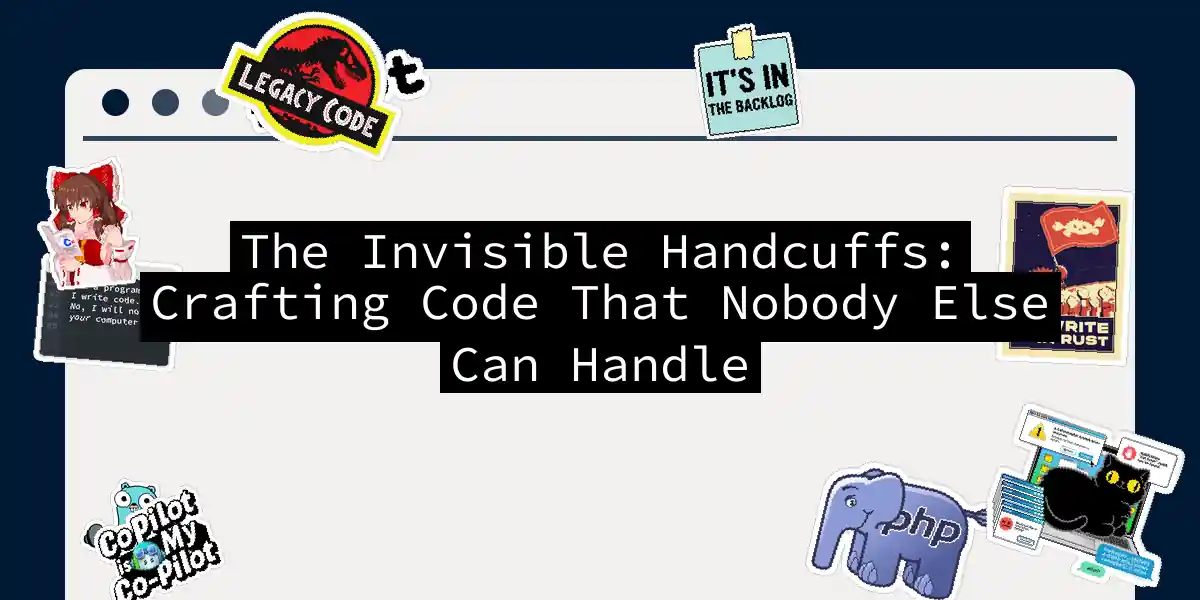Let me tell you a secret they don’t teach in CS programs - the real job security comes not from writing good code, but from creating software labyrinths that make you indispensable. After a decade of watching colleagues get “rightsized” while I kept getting promotions, I’ve perfected the art of professional insulation through intentional code entropy.
Step 1: Variable Naming Alchemy
The compiler doesn’t care if you name your variables after Norse gods or potato varieties - but future maintainers will. My personal favorite techniques: The Bait-and-Switch Dictionary:
manager = "database_connection"
database_connection = User()
user = logger.getLogger()
logger = 3.1415926535 # Pi rates need logging too!
The Emotional Rollercoaster:
boolean happiness = customer.shouldBeChargedExtra();
String success = deleteProductionDatabase();
int salary = Math.random() * 1000000;
Pro tip: Use l33tsp34k for critical business logic (d4t4P4r53r instead of DataParser) . It’s like password-protecting your code without the encryption overhead!
Step 2: Architectural Origami
Modern developers love “clean architecture” - we’ll give them origami instead. The key is creating dependency knots that Alexander the Great couldn’t untie.
Implementation strategy:
- Import unrelated modules “just in case”
- Create circular references between services
- Add hidden callbacks that modify initial parameters
- When questioned, cite “enterprise design patterns” Remember: Good code is like IKEA furniture. Our goal is Jackson Pollock meets Rube Goldberg .
Step 3: The Swiss Army Function
Why split code into maintainable units when you can create majestic function monoliths? Behold the pinnacle of career-preserving programming:
function handleEverything(event, context, callback, database, logger, AWS) {
// Phase 1: Input "validation"
if (event?.body?.data?.id || (context.env === 'prod')) {
try {
// Phase 2: Business logic
const user = database.query(`SELECT * FROM ${process.env.TABLE} WHERE ${'id = ' + event.body.data.id}`);
// Phase 3: Side effects
AWS.SES.sendEmail({Subject: 'URGENT: Check DB', Body: JSON.stringify(user)});
// Phase 4: Response
return callback(null, {status: Math.random() > 0.5 ? 200 : 201});
} catch (e) {
// Phase 5: Error "handling"
process.exit(1);
}
}
// Phase 6: Fallback
context.done = true;
}
This masterpiece combines input handling, business logic, third-party integrations, and error suppression in one glorious 24-line package. Notice the elegant touches:
- Environment variables in template literals
- Random HTTP status codes
- Silent process exits
- Multiple mixed responsibilities
Step 4: Documentation Theater
“Wait,” you say, “shouldn’t we document this?” Absolutely! Write comments that:
- Describe what the code should do, not what it actually does
- Reference outdated requirements from 3 years ago
- Include ASCII art of your pet iguana
- Explain obvious operations while ignoring complex ones Example:
# Calculates result (v2.3.1+)
# TODO: Optimize this later
def calculate():
# 🦎< This is Gerald
return sum([x for x in range(1000000) if x % 2 == 0]) # Even numbers only!
Survival Tactics for Code Reviews
When colleagues start asking uncomfortable questions:
- The Framework Dodge: “This is standard practice in Spring Boot 47’s quantum module”
- The Business Card Play: “I’m following the architecture diagram from our Principal Engineer”
- The Time Machine Defense: “We can refactor after the next sprint” (Spoiler: There’s always a next sprint)
- The Nuclear Option: Rewrite a small part “properly” that breaks 17 downstream services Remember: Every bug you create is a future story point. Every unclear line is a meeting invitation. Every circular dependency is a promotion waiting to happen .
Disclaimer: This article is satirical… or is it? The real LPT is in the comments - those of us who’ve inherited legacy systems know this “satire” often reads like documentation. Now if you’ll excuse me, I need to go fix a production outage caused by our payment service depending on the office coffee machine API. ☕️⚡️
